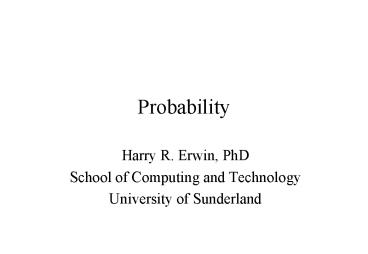Probability - PowerPoint PPT Presentation
1 / 25
Title:
Probability
Description:
Hatch, E.M. and Farhady, H. (1982) Research Design And ... Blaise Pascal and Pierre de Fermat invented the modern theory of probability. Basic Definitions ... – PowerPoint PPT presentation
Number of Views:61
Avg rating:3.0/5.0
Title: Probability
1
Probability
- Harry R. Erwin, PhD
- School of Computing and Technology
- University of Sunderland
2
Resources
- Rowntree, D. (1981) Statistics Without Tears.
Harmondsworth Penguin. - Hinton, P.R. (1995) Statistics Explained. London
Routledge. - Hatch, E.M. and Farhady, H. (1982) Research
Design And Statistics For Applied Linguistics.
Rowley Mass. Newbury House. - Crawley, MJ (2005) Statistics An Introduction
Using R. Wiley. - Gonick, L., and Woollcott Smith (1993) A Cartoon
Guide to Statistics. HarperResource (for fun).
3
Module Outline
- Introduction
- Using R
- Data analysis (the gathering, display, and
summary of data) - Probability (the laws of chance)
- Statistical inference (the drawing of conclusions
from specific data knowing probability) - Experimental design and modeling (putting it all
together)
4
Lecture Outline
- Introduction
- Basic Definitions
- Basic Operations
- Conditional Probability
- Independence
- Bayes Theorem
- Discrete Random Variables
- Continuous Random Variables
- Examples
5
Introduction
- Historically, probability has had one
application gambling - Claudius (Roman emperor, 10 BCE-54 CE) wrote the
first book on gambling How to win at dice - Blaise Pascal and Pierre de Fermat invented the
modern theory of probability
6
Basic Definitions
- Random experiment the process of observing a
chance event - Elementary outcomes the possible results
- Sample space the collection of all elementary
outcomes, written outcome1, outcome2, - The probability of outcome1 is written P(outcome1)
7
Heads or Tails (fair coin)
Outcome Probability
Heads 0.5
Tails 0.5
8
In the play Rosenkrantz and Guilderstein are Dead
Outcome (note same sample space) Probability
Heads 1.0
Tails 0.0
9
Fair Die
Outcome 1 2 3 4 5 6
Prob 1/6 1/6 1/6 1/6 1/6 1/6
10
A Pair of Fair Dice
2 3 4 5 6 7 8 9 10 11 12
1/36 2/36 3/36 4/36 5/36 6/36 5/36 4/36 3/36 2/36 1/36
11
Can You Imagine a Way of Testing Whether a Die is
Fair?
- Discuss
12
Rules of Elementary Probability
- The probability of any outcome in the sample
space is between 0.0 and 1.0 (non-negative) - The total probability of all outcomes in the
sample space is 1.0 - Suppose the probability of outcome1 is p. The
total probability of any other outcome is 1.0-p.
13
Basic Operations
- An event is a set of elementary outcomes. The
probability of the event is the sum of the
probabilities of the outcomes in the set. - An event is written list of outcomes
- Suppose you roll a die twice, and the sum is 3.
The set of events corresponding to this is
(1,2),(2,1) - The probability of this event is 1/36 1/36
- What is the probability of getting a sum of 4?
14
Possible Events
- E and F, meaning both event E and event F
occur. - E or F, meaning either event E or event F
occur. - not E, meaning event E does not occur.
- P(E or F) P(E) P(F) - P(E and F)
- If the events are mutually exclusive, P(E or F)
P(E) P(F) - Finally, P(not E) 1.0 - P(E)
15
Conditional Probability
- Suppose you have two events E in sample space A
and F in sample space B. - P(EF) is the probability of E given that F
happens. - P(EF) P(E and F)/P(F)
- P(E and F) P(EF)P(F) P(FE)P(E)
- Note P(EE) P(E and E)/P(E) P(E)/P(E) 1
- Also P(EF) 0 if they are mutually exclusive
16
Independence
- Two events are independent if the occurrence of
one has no influence on the other. - If two events, E and F, are independent,
- P(E and F) P(E)P(F)
17
Bayes Theorem
- Suppose you know P(AB) and you want to calculate
P(BA) - P(BA)P(A) P(AB)P(B)
- P(BA) P(AB)P(B)/P(A)
- A rare disease has a prevalence of 1/1000
- There is a test that is 99 accurate when you
have the disease. - The test also reports 2 positives when you
dont. - You just had a positive test result. What are
your chances?
18
Solution
- Look at 1000000 people, of whom 1000 have the
disease - 999000 dont hence 19980 false positives
- 1000 do hence 999 true positives
- Your chances of having the disease given you had
a positive test result are 999/(19980999)
1/21. Why? - P(I and X) P(IX)P(X) P(XI)P(I)
- P(IX) P(XI)P(I)/P(X) 0.9990.001/P(X)
- And P(X) P(XI)P(I)P(Xnot I)P(not I)
0.9990.0010.020.999 0.0210.999 - So P(IX) 1/21
19
Discrete Random Variables
- A random variable is the numerical outcome of a
random experiment. - Each possible outcome has a probability.
- Histograms can be used to graph these.
20
Demonstration Using R
21
Continuous Random Variables
- Random variables can be continuous
- Your height
- Your weight
- Your age
22
Examples of Continuous Random Variables Using R
23
You Can Also Discuss the Cumulative Probability
Distribution
- This the probability of a result between the
smallest possible value and a given value. - Mathematically, it is area, calculated by summing.
24
Examples
25
How you use probability
- In your experimental work, you show that a null
hypothesis has very low probability of being
correct. - That means the necessary probabilities must be
evaluated easily. - Discussed in the next lecture.































